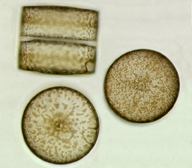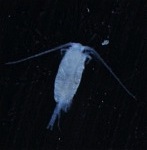Hurrah, the bloom is on it’s way! Since ten days now the phytoplankton cell numbers are increasing steadily. The weather has been exceptionally nice and sunny over the last two weeks, spoiling the phytoplankton with plenty of light. Finally the conditions are perfect for the diatoms to bloom.

Huge burgers in a glass box: the diatom Coscinodiscus sp. – juicy food encaged in a silica frustule. With its size of up to 0.5 mm in diameter, Coscinodicus is the largest diatom in the ocean. Foto: AWI
Interestingly it’s not just the diatoms that are thriving. Also some of the much smaller nanoplankton groups are flourishing under the spring sun. The nutrients are declining fast, so soon the large and the small guys will be competing fiercely for the waning nutrients.
So finally the table is being set for the hungry copepods in our mesocosms. After this long wait, however, they may not be too happy about what’s on their plate. Instead of the manageable food packages, which they are normally served during diatom spring blooms, they find themselves surrounded by these huge burgers in glass boxes, named Coscinodiscus. Too big for Pseudocalanus, the dominant copepod in our mesocosms, to be swallowed in one piece and too sturdy to be chewed into pieces. Putting myself into the shoes of Pseudocalanus I would be quite upset. It must feel like waiting with an empty stomach in front of a grocery store with lots of delicious food in the display window. And there is no way to open the door.
A clear sign that the copepods are not having the feast of their lives shows up in the material Tim and Mathias are collecting from the sediment traps. While they were full of copepod faeces during the first couple of weeks of our experiment, there are hardly any faeces arriving in the traps at this stage.

With only 2 mm in length, Pseudocalanus sp. is too small to swallow the big burgers and too weak to crack their silica frustules. Foto: Fisheries and Oceans Canada
It appears that also the tiny nanoplankton, which is prospering along with Coscinodiscus, is not filling their stomachs, despite there being over 70,000 of them in each ml of seawater. They may simply be too small for Pseudocalanus to catch them.
There are still enough nutrients for the phytoplankton community to double its abundance. I am curious to see who will win this contest. And what will eventually happen to Pseudocalanus? Most importantly, will ocean acidification affect the end of this tale?